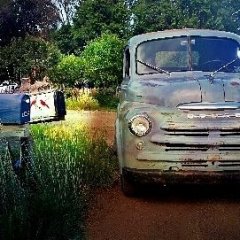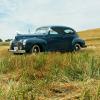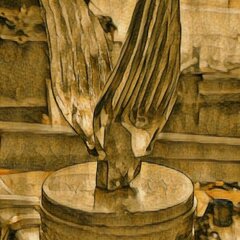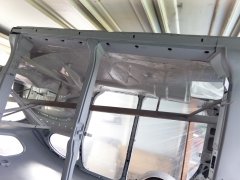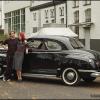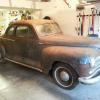Search the Community
Showing results for tags 'paint'.
-
So I'm going to paint my car a light blue similar to the original color. But I'm thinking to paint the roof white. I was thinking painting from dripedge up leaving the door surrounds blue. I see that Adam h painted from the trim at the body line up which was my other thought. I'm checking to see what you guys think looks better.
-
In the process of refreshing a collection of 1950 Dodge dog dish hubcaps. Does anybody know what color of red was originally used? I used a color meter and came up with hex code #A83928 and or RGB 168 57 40. A quick trip to the hobby shop netted me a close equivalent - Model Master 2732 Chrysler Engine Red. I've been unable to find it in a spray can. Perhaps if I had a color code of some kind I could get a spray can mixed up?
- 21 replies
-
I recently saw a '53 Pilothouse 1/2 ton that is painted all-black except for the correct yellow wheels. I have not seen all black before, was that an offering in 1953? Crossposted to Pilothouse group. Thanks!
- 4 replies
-
- pilothouse
- black
-
(and 3 more)
Tagged with:
-
Hi everybody, I posted this in the Car section as well, as I wasn't entirely sure where to put it. My brother has a 1956 Dodge truck and we are looking for paint chips/ paint codes for it. It is a two-tone, we believe the colours are Pontchartrain green for the lower half and Banner Green for the upper half. It is a Canadian truck though, are the paint codes, or even the colours the same? We own a 1940 Dodge as well and know that the original blue colour is either exclusive to Canada, and the original paint chips are long gone or no longer being mixed, I can't quite remember which. The trucks I believe were painted in commercial paint colours- were these commercial colours shared across the US- Canadian Border? Thanks in advance, Dean
-
From the album: 49 P15C update
I used DP-50 primer & shot a high grade poly. -
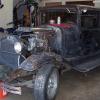
Preventing rust on bare metal parts waiting for paint
3046moparcoupe posted a topic in P15-D24 Forum
We don't have it as bad as the Houston Tx area, but the DFW metroplex area of Texas can hit ya with high humidity levels for extended periods of time and it can change at the drop of a hat. The following is something I wanted to share with members in regards to this - hopefully it might help someone out a bit. For about $10 here's what I've done to keep humidity off parts were wire wheeled down to bare metal in preparation for paint, then had to sit for days if not weeks due to rainy high humidity weather. Wallmart carries a line of plastic sealing bags called "magicbag", They are space saver type bags and they come in different sizes....(don't confuse this brand with the ziploc type bags they also carry,...I have had about 75% of the Ziploc bags come apart at the seal after only a single use, the magicbag's seem to be better made and don't do this),... I just purchased a box of 3ea magicbag's size 18" x 24" for $4.00,.....cast iron intake manifold fits right in it with room left over,....flywheel would fit with room to spare, etc...just an example , but they also have larger sizes that cost a bit more.... Wallmart also carries a line of cat litter called MiMi Kitty, it is made up entirely of Silica Gel Crystals, and you can get a 4 lb bag of it, for $4.99. I took some of my old plastic prescription bottles, removed the white plastic lid, then drilled the plastic lid with 4-6 holes to allow air flow, then cut a small circle out of a paper towel and insert the circle into the inside of the plastic cap you just drilled holes into. Now fill your bottle with the silica gel crystals and screw the cap onto the bottle, then re-seal your litter bag with tape so it stays freash and dry for future use Place your part and the bottle inside the plastic bag and seal the double seal of the bag,..then grab your vacuum and suck the air out of the one way valve on the bag. Your part is now vacuum sealed inside the bag which also contains a supply of desiccant.....be easy with the vacuum as it will pull the plastic in and onto the part very quickly - I have wondered about a sharp part edge ripping the plastic and defeating the purpose, so I've experimented a bit and pulled the bag down to where it was completely vacuum sealed against the part which had bolt heads and studs sticking out and it did not tear or rip the plastic.. again these magicbag's are much better made bags than the Ziploc brand. Hope this helps someone. Steve- 1 reply
-
- 1
-

-
- rust
- bare metal
-
(and 2 more)
Tagged with:
-
Hello!, I would like to ask you for a bit of help. My car, an export DeSoto SP15 equal to a Plymouth P15, finally is on a body shop to be repaired and painted. Hopefully upholstery will be done too. The car doesn't have its original interior, and we're having some doubts about the colors to use (the exterior of the car is black) for the seats, and mainly the roof liner, dash and upper part of the doors (around the windows). So, if anyone here who owns a P15 with an original interior (or redone with the original colors, or something close to that to get some ideas) and can post a few photos of the dash, roof, doors and seats, that would be of great help! Thanks! and greetings from Uruguay! Fede
-
Hi everyone, first post here. Great looking site with great information. I am hoping someone can help me with a query I have. My family has what is almost certainly a Canadian built D15 and I am looking to decipher the data plate on the firewall. I know information is sketchy at best...especially for Canadian built cars, but any help is greatly appreciated! The tag reads: D15 2DR SED 1317 1559 AKF 1317 is the body number, correct? As in the number of the D15 body that rolled down the line? Does anyone know what 1559 paint code or AKF trim code is? The car was owned for roughly 40 years by the same owner before he passed away and we purchased from his family last year. The car was clearly cared for and driven often, and will continue to be loved and driven. Luckily he had stored away A TON of spare parts and Canadian specific manuals. None of the manuals have been too much help with colour/ option information or history unfortunately. Thanks for your help! Dean
- 15 replies
-
When I get bored, I either tear something up or I fix something that I've previously broken. This week I figured I'd break out the paint gun, fire up the air compressor, and redo the cheapo paint job I put on Jenny when I first got her. I spent a couple of days fixing all the little nicks and dings she acquired over the last couple of years. I then masked her up and laid down the paint today. Here's the results. I'll be letting the paint cure for a couple of weeks then I'll cut and buff to get rid of the little bit of water I got in a spot or two because is was so humid when I sprayed it. more to come
-
Hello all, as I got here lot's of great tips I maybe have one for you. When I bought my Dodge, the speedometer and clock were really destroyed. The printed surface was deteriorated and also the printed letter of the clock and speedometr face dropped off. When I decide to restore it I tried several ways like screen printing, or find somebody who does this professional but it would all be too complicated or to expancive. As a result I will show the way I did it maybe it helps somebody. At first, I took the old clock face and layed it on the scanner of PC. After scanning I reconstructet the letters in Adobe Illustrator to create vector grafics. I made two layers, one for the white print and one for the black. I gave both files to a printing shop to plot too masking films. Better make two or three of each, you will use them propably. At first pull of release paper and stick foil to the glass. I let the glass cut in a local shop. Markings on the foil help to find the exact position Now pull off transfer foil and paint the letters and stripes. After a few tests I use color for scale models. It adheres better as glass paint, but don't ask me why. Because of the flat surface paint doesn't stick very good to glass, you have to pull of the masking film before color ist completely dry. Sometimes, if the color was too dry or it doesn't stick well to the glass, the edges of some letters are not straight. If you have a second masking film cut out the letters and stick it to the exact position to repaint the edges. If the first color is done, you have to make the black outline. That is even harder because the line is smaller then one Millimeter (sorry for the metric system :-) I found out, that you can't use the complete masking foil to stick over the white because of two reasons. 1. If you pull of the release paper, the masking foil seems to stretch a little bit. It's not much but it's enough that the tin lines won't fit 2. The masking film will rip of the thin white lines. To avoid that I took small pieces of masking film and normal paper and stick it over the thin white lines. Then I took the whole glass and glued it against a window with masking tape. This helps you to position the masking foil for the numbers because when the numbers are still on the transfer foil you really cant't look though it and it's difficult to find the right place. If you're finished, it lookes like that: Now I took black enamel paint for the outlines. Check from the other side if the lines look good and pull off masking foil quick befor color gets too dry. The finished clock face looks pretty nice. On the first look, you can't differ from the original. When I had a closer look to my old one, it wasn't sooooo exact either. Hope this will help others who have the same problem. The background I also made on Illustrator. I printed the pattern on a foil and the golden foil is aluminium foil to make christmas stars from a hobby shop. I layed it on a ripped plastic surface that I found on an old plastic casing and pressed the foil on the plastic with a rubber roll. Then I took glue and sticked it to the foil with the pattern. This really is just a compromise, because the ribbed structure ist not so fine as original and also not so exact, but it's doing it's job. Also the car istn't perfect the clock might ot be perfect too. Here in Germany we have to show Kilometers on speedometer. Normaly you have to glue stickers on the screen. When I was rebuliding the speedometer face I changed the letters into Kilometers :-) I did this to my 42 Dodge an still have the files. If anyone ist interested I could send them the EPS-Files. Hope this helps Kai
- 16 replies
-
- 4
-

-
- clock
- speedometer
- (and 5 more)
-
I saw this paint scheme on the H.A.M.B. Very nice!
-
I was all ready to prime my cab today, except found out my primer is getting old. When I went to order more epoxy primer I find out Summit can't ship it to California. A lot of the paints/primers can't be shipped to CA anymore. So, California guys, what do you recommend for a good epoxy primer? Or do I need to drive to Nevada and pick it up myself? Anyone in NV want to go by Summit and ship it to me? I'm stuck until I resolve this.
-
I'm currently rebuilding my B-4-B's power plant and restoring the engine compartment close to factory condition as part of the project. Does anybody know which brand of paint most closely matches the silver engine color? Also, I wanted to get your input on the correct factory paint colors for the following items...I've taken a guess for each part: Air Cleaner: Semi-gloss black Bellhousing: Silver Bellhousing Pan: Gloss Black (?) Breather Cap: Semi-gloss Black Breather Tube: Silver Draft Tube: Semi-gloss Black Engine Block: Silver Fan: Semi-gloss Black Frame: Flat black (?) Front Motor Mount to Frame Bracket: Semi-gloss black Front Motor Mount to Engine Bracket: Silver Generator: Semi-gloss Black Inner Fenders: Semi-gloss Black Intake Manifold: Silver Master Cylinder: Natural Cast Iron Oil Filter: Semi-gloss Black Oil Pan: Silver or gloss black (?) Pulley, Water Pump: Semi-gloss Black Pulley, Crankshaft: Silver Radiator: Gloss black (?) Radiator Core Support: Semi-gloss Black Starter: Semi-gloss Black Steering Box: Natural Cast Iron Timing Cover: Silver Transmission: Silver Upper Radiator/Grill Shell Filler Panel: Semi-gloss Black Water Pump: Silver
- 14 replies

